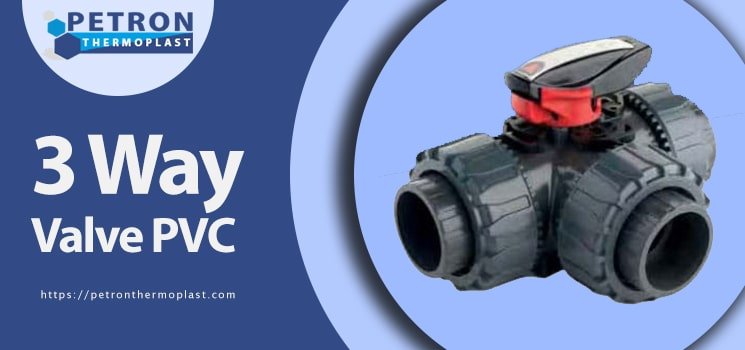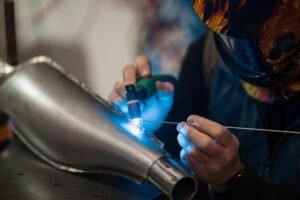A Complete Guide for 3 Way Valve PVC Flow Patterns
The most popular forms of ball valves are two-way and three-way valves. Due to their configuration options, three-way ball valves are particularly practical for controlling the flow of gases and fluids. They can be used, for instance, to switch the oil flow from one tank to another.
Three-way ball valves can
- Reduce or stop the flow
- Change the direction of flow between two sources
- Streamline the flow coming from two sources.
- Alternate movement between two distinct locations
- Change the direction of flow originating from one source to another.
- Split flow from a single source to two final destinations
This article focuses on the fundamental variations in design between three-way ball valves with L-pattern (L-port) flow and those with T-pattern (T-port) flow. Also, go through several methods for controlling flow through standard 3 Way Valve PVC designs using handle position in conjunction with handle rotation range.
How is a three-way ball valve different from a two-way ball valve?
In a closed tube or pipe systems, two-way ball valves are frequently employed as shut-off valves for gases or liquids (media). This is a result of their dependability and simplicity. Two ports or apertures on two-way valves allow for the connection of pipe or tubing to the 3 Way Valve PVC. In two-way ball valves, the media—liquid or gas—passes through the valve through a single, straight hole in the ball.
Have questions about whether a three-way ball valve is the best option for your application? Learn some advice and knowledge about selecting small ball valves. Because the bore through the ball within a conventional port ball valve is less than the diameter of the pipes attached to the valve ports, the flow through the valve is somewhat constrained. Using a full port ball valve is one way to lessen or eliminate flow resistance with a ball valve.
Three ports or connectors for pipe are included on three-way ball valves. Three-way valves can often address more complicated flow control requirements than two-way valves. They are, therefore, beneficial for a variety of process applications. For instance, a certain kind of three-way ball valve can be used to combine juice concentrate and filtered water from different sources. Gasoline could be diverted from one tank to another using a modified three-way valve arrangement, with the ability to stop the fuel flow completely. It’s crucial to comprehend the main three-way valve design possibilities and consider the intended usage of the valves when selecting the best 3 Way Valve PVC. First, some fundamentals.
What is a three-way ball valve?
Multi-port valves are three, four, and five-way ball valves. The most popular multi-port ball valve is the three-way ball valve. A three-way ball valve has three ports or apertures for the passage of media, such as gas or fluids, attached to a pipe or tubing. Depending on the flow direction via the valve, these ports typically have one inlet and two outlet ports or one outlet and two inlet ports. Three-way ball valves are common because they offer shut-off and flow direction control in a single valve body in an affordable and straightforward manner.
Three-way valves can control flow by adjusting the pipe configuration, the valve ball’s handle rotation, and the flow route through the valve ball (the ball bore or porting). With the appropriate valve type and configuration, the flow may be regulated to satisfy one or more distinct process needs, including
- Turn off the flow entirely.
- Combine the output of two sources
- Split flow from a source between two separate destinations
- Divert flow from one destination to the other
- Alternately, stop one direction of flow while allowing another to continue.
What a three-way ball valve is capable of depends on one little but crucial internal design change. The pattern of flow or port shape via the ball within the valve is this significant design distinction. A capital L (L-pattern flow, L-flow, L-port, two direction) or a capital T (capital T) are the two most common shapes for the valve balls on three-way ball valves (T-pattern flow, T-flow, T-port, three directions).
L-pattern valve balls have flow paths shaped like a capital L
The most popular way to let flow from one common input port out into one of two separate outlet ports is to employ L flow patterns, sometimes known as 90-degree balls. L-pattern flow three-way ball valves are frequently referred to as diverter valves because of this.
What is a diverter valve?
L-pattern flow ball valves are also known as diverter, selecting, or directing valves. This is due to the widespread usage of this 3 Way Valve PVC design to modify or redirect the flow leaving through one of two separate valve outputs or ports. The common or flow entrance port of manual three-way L-pattern ball valves used as diverter valves is typically located at the bottom port of the valve body. Two-position valves are another name for L-pattern flow ball valves with handles that may rotate 90 degrees (a quarter turn of the handle). With a single 90-degree turn of the handle, they may direct flow to the left or right.
The bottom port, often known as the common port, is always open for a vertical L-pattern flow ball valve. The flow can be diverted to the left or the right by turning the valve handle 180 degrees (or a half-turn) (see the previous images). The handle faces the front or the back of the valve if the valve is turned only 90 degrees (a quarter turn) in either direction. The valve’s flow is stopped at these handle settings. The handles on many vertical-type L-pattern flow valves can only be turned 180 degrees or a half turn. This offers all three options—the left flow, the right flow, and the one-off position.
What are two position L-pattern flow ball valves?
It starts to become tough at this point. A standard L-pattern flow three-way ball valve (see above) is frequently capable of only one handle rotation of 90 degrees. The term “two-position valve” typically refers to this basic three-way ball valve. A diverter, selector, or directional valve are other names for it.
Why do handles matter for three-way ball valves?
Handle stops of some type limit how far a ball valve handle may rotate (red arrows). These often extend the handle and the top of the 3 Way Valve PVC body. They work by obstructing handle rotation. These stops block the handle from rotating past a predetermined distance.
Three-position L-pattern flow ball valves
Ball valves with an L-flow pattern and three positions are also available. The handle can only be turned a maximum of 180 degrees. A smooth flow channel between the left and bottom ports might be the starting point for the handle location in a system like this. The valve still permits flow when the handle is turned 90 degrees anticlockwise to its second position; however, this time, the flow is between the bottom and right ports.
All flow via the valve is stopped by turning the valve a further 90 degrees anticlockwise for a total of 180 degrees (position 3). These three-position L-pattern flow ball valves have a starting position, a 90-degree turn, and a 180-degree turn.
Conclusion
Flow patterns (L-pattern or T-pattern flow), handle orientation (horizontal type or vertical type), and the number of 90-degree revolutions the handle is permitted to spin are often used to characterize three-way ball valves:
- Two positions (90 degrees)
- Three positions (180 degrees)
- Four positions (270 or 360 degrees)
Gas and liquid flow can be changed, mixed, blocked in one direction, or fully stopped depending on how the valve ball is drilled and how the pipework is set up. Petron valves can eliminate an additional tee and valve while saving space. It is simpler to select the ideal 3 Way Valve PVC and organize its installation if you know the fundamental three-way ball valve design possibilities. Please visit the website of Petron Thermoplast and Learn more!




